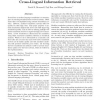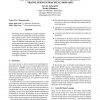COLING
2002
14 years 3 months ago
2002
The purpose of this study is to propose a new method for machine translation. We have proceeded through with two projects for report generation (Kittredge and Polguere, 2000) : We...
COLING
2002
14 years 3 months ago
2002
A number of machine translation systems based on the learning algorithms are presented. These methods acquire translation rules from pairs of similar sentences in a bilingual text...
COLING
2002
14 years 3 months ago
2002
Less than 1% of the languages spoken in the world are correctly "computerized": spell checkers, hyphenation, machine translation are still lacking for the others. In thi...
ENGL
2008
14 years 3 months ago
2008
In one form or another language translation is a necessary part of cross-lingual information retrieval systems. Often times this is accomplished using machine translation systems....
ICASSP
2010
IEEE
14 years 3 months ago
2010
IEEE
Integrating Parts of Speech (POS) information to Machine Translation (MT) model usually amounts to significant changes in the MT decoder. We present a method to rapidly integrate...
COLING
1990
14 years 4 months ago
1990
Tiffs lmper concerns an approach to Machine Translation whieJJ differs from the typical 'standard' approaches crucially in.that it does not rely on the prior existence o...
COLING
1992
14 years 4 months ago
1992
Within the industrial context of the information society, technical translation represents a considerable commercial stake. In the light of this, machine translation is considered...
COLING
1992
14 years 4 months ago
1992
Knowledge-based interlingual machine translation systems produce semantically accurate translations, but typically require massive knowledge acquisition. Ongoing research and deve...
COLING
1992
14 years 4 months ago
1992
This paper proposes a two-phase example-based machine translation methodology which develops translation templates from examples and then translates using template matching. This ...
COLING
1990
14 years 4 months ago
1990
We describe a semi-automatic semantic disambiguator integrated in a knowledge-based machine translation system. It is used to bridge the analysis and generation stages in machine ...


